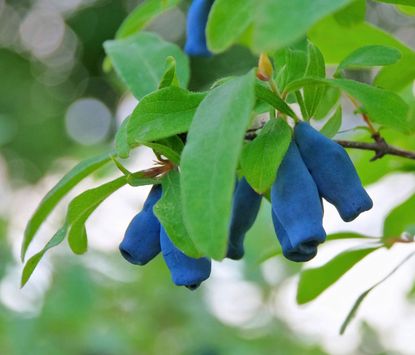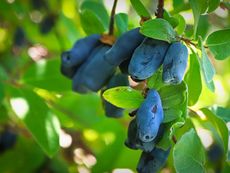Haskap Berry Info – How To Grow Honeyberries In The Garden


Honeyberries are a treat that really shouldn’t be missed. What are honeyberries? This relatively new fruit has actually been cultivated in cooler regions by our ancestors. For centuries, farmers in Asia and Eastern Europe knew how to grow honeyberries. The plants are native to Russia and have a remarkable cold tolerance, surviving temperatures of -55 degrees Fahrenheit (-48 C.). Also called haskap berry (from the Japanese name for the plant), honeyberries are early season producers and may be the first fruits harvested in spring.
What are Honeyberries?
Fresh spring fruits are something for which we wait all winter. The first honeyberries taste like a cross between raspberries and blueberries. They are excellent eaten fresh or used in desserts, ice cream and preserves. Related to the blueberry and huckleberry, haskap berry is a heavy producing plant that requires little special care. Honeyberries (Lonicera caerulea) are in the same family as blooming honeysuckle, but they produce an edible fruit. Birds and other wildlife love the berries and the attractive shrubs grow without much encouragement in temperate and cool zones to a height of 3 to 5 feet (1 to 1.5 m.). The term haskap refers to the Japanese varieties, while edible honeysuckle refers to the Siberian hybrids. The plant produces a 1-inch (2.5 cm.), oblong, blue berry with a flavor that fails to be classified by most eaters. It is said to taste like raspberry, blueberry, kiwi, cherry or grapes, depending upon the taster. The sweet, juicy berries are experiencing new popularity among European and North American gardeners.
Propagating Honeyberry
Honeyberries require two plants to produce fruit. The plants need to have a shrub that is unrelated nearby to pollinate successfully. The plant roots easily from dormant stem cuttings and fruits in two to three years. Cuttings will result in plants that are true to the parent strain. Cuttings can root in water or in the ground, preferably a soilless mixture until a good cluster of roots have developed. Then, transplant them to a prepared bed where drainage is good. Soil may be sandy, clay or almost any pH level, but the plants prefer moderately moist, pH 6.5 and organically amended mixtures. Seeds require no special treatment, such as scarification or stratification. Propagating honeyberry from seed will result in variable species and the plants take longer to fruit than stem cutting plants.
How to Grow Honeyberries
Space plants 4 to 6 feet (1.5 to 2 m.) apart in a sunny location and plant them at the depth they were originally planted or deeper in amended garden beds. Ensure that an unrelated variety of honeyberry is nearby for cross pollination. Water regularly the first year but allow the top surface of the soil to dry out in between irrigation periods. Mulch 2 to 4 inches (5 to 10 cm.) deep around the plant’s root zone with leaf litter, grass clippings or any other organic mulch. This will also help keep competitive weeds away too. Apply compost or manure in spring to add nutrients. Fertilize according to a soil test. Pests are usually not a problem, but protection from birds is an important part of honeyberry care if you want to preserve the fruit. Use a framework of bird netting over the plants to keep your feathered friends from enjoying all your efforts. Additional honeyberry care is minimal but may involve some pruning and watering.
Gardening tips, videos, info and more delivered right to your inbox!
Sign up for the Gardening Know How newsletter today and receive a free download of our most popular eBook "How to Grow Delicious Tomatoes."

Bonnie Grant is a professional landscaper with a Certification in Urban Gardening. She has been gardening and writing for 15 years. A former professional chef, she has a passion for edible landscaping.
-
 Urban Beekeeping Guide: Top Tips For Raising Bees In The City
Urban Beekeeping Guide: Top Tips For Raising Bees In The CityUrban beekeeping can be a rewarding and appreciated pastime, but first be sure it’s legal in your city and learn the ropes of beekeeping.
By Mary Ellen Ellis
-
 2024 Plant Of The Year: Why Experts Say Philodendron Is The “It” Plant Of The Year
2024 Plant Of The Year: Why Experts Say Philodendron Is The “It” Plant Of The YearWe aren’t surprised that philodendron was designated the plant of the year. Versatile, easy-care and lovely, it’s the houseplant of the year 2024!
By Bonnie L. Grant
